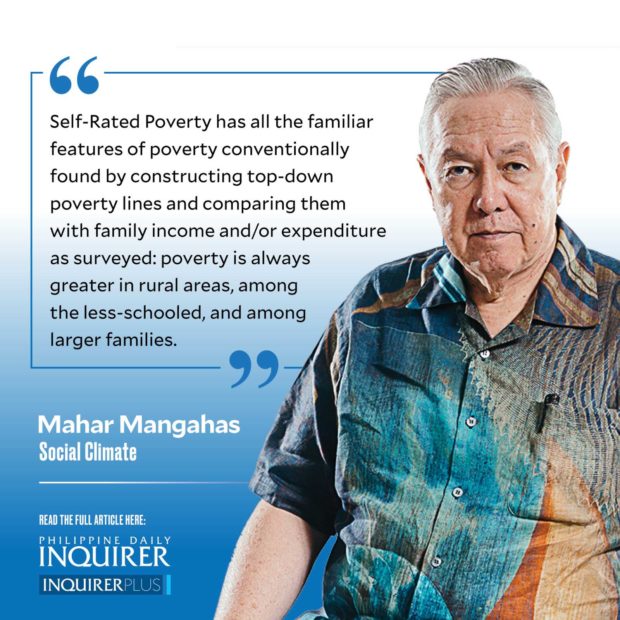132 poverty surveys in 40 years

The first and second (in 1985) SRP-surveys were done by pre-SWS institutions, also under my direction. The SWS series started in 1986, initially twice a year, and became quarterly since 1992, except for missing Quarters 1 to 3 of 2020 when the pandemic’s restrictions on public transportation prevented face-to-face interviewers from being fielded.
To me, what is striking about the new report is that the Not Poor (literally, Hindi Mahirap) are now less than one out of five, which I don’t remember happening before. This is purely the self-identification of so many household heads with the thin Line shown on a card between the terms Mahirap and Hindi Mahirap.
Article continues after this advertisementThough the Line shown is thin, those feeling on it are now twice as many as those feeling across it. The interviewer has no words for the line; she simply asks the respondent to point to the location of the family on the show-card.
By area, the new Mahirap versus Hindi Mahirap percentages are: 25-28 in Metro Manila, 41-25 in Balance Luzon, 59-8 in Visayas, and 43-9 in Mindanao.
Self-Rated Poverty Thresholds. The SRP system does not impose any poverty threshold on the respondent. It asks a poor respondent to say what monthly peso budget for home expenses would be enough in order not to feel Mahirap anymore? The Self-Rated Poverty Threshold is the Cost of Living, excluding the Cost of Earning such as transportation to work, or mobile phone load, which all families need now.
Article continues after this advertisementThe median SRP Thresholds, per month, are now P15,000 in Metro Manila, P15,000 in Balance Luzon, P12,000 in Visayas, and P10,000 in Mindanao. These bottom-up thresholds are very modest. The Visayans and Mindanaoans are not poorer because they ask for much more than Metro Manilans and other Luzonians.
The Self-Rated Poverty Gap is asked separately: how much does a poor respondent lack, per month, in order to reach its own Poverty Threshold? The median SRP Gaps are very significant: P7,500 in Metro Manila, and P5,000 in the other three areas. They are in the thousands, not mere hundreds, of pesos. This shows how puny is the ayuda of P300 or even P500 per household.
Self-Rated Food Poverty. This applies the same system to the quality (not the quantity, which is handled by a separate Hunger indicator) of the food of the respondent’s family. Naturally, food poverty is always somewhat less than general poverty. Those calling their food Mahirap are now 31 percent; those calling it Hindi Mahirap are 24 percent; and those pointing to the Line are a 44 percent plurality.
By area, with respect to the family’s food, the new Mahirap versus Hindi Mahirap percentages are: 21-27 in Metro Manila, 31-35 in Balance Luzon, 41-15 in Visayas, and 31-10 in Mindanao.
Self-Rated Food Thresholds and Gaps. Using corresponding questions, the December 2021 SWS survey finds that the monthly food poverty thresholds and gaps are, respectively: P8,000 and P4,500 in Metro Manila, P9,000 and P4,000 in Balance Luzon, P7,000 and P3,000 in Visayas, and P5,000 and P2,000 in Mindanao. Note that the gaps are thousands, not mere hundreds, of pesos.
The self-rating system has provided the Philippines with the world’s most rapid survey-based monitoring of poverty, however defined. It is a living, breathing survey series, which can go on indefinitely.
SRP is deliberately measured quarterly, in order to compete with the gross national product for public attention. GNP is constantly watched by public and private institutions since it is correlated with their own bottom lines. But it is a very faulty indicator of changes in economic welfare: as long as it grows faster than the population, the facile assumption is that it trickles down to the poor.
SRP has all the familiar features of poverty conventionally found by constructing top-down poverty lines and comparing them with family income and/or expenditure as surveyed: Poverty is always greater in rural areas, among the less-schooled, and among larger families.
The great advantage of the self-rating system is that it is very economical, using only a few minutes out of an hour-long questionnaire that then has room for many other important aspects of human well-being and the “social weather.” In this way, SWS has now generated four decades of quarterly data from which to understand the dynamics of poverty.
——————
Contact: mahar.mangahas@sws.org.ph
















